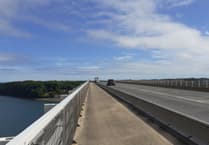This hand-coloured photograph shows a regiment of soldiers stationed at Llanion Barracks, which is seen in the background, marching up Water Street, Pembroke Dock, in a period before the First World War. By this time, the original wooden huts that made up the barracks had been replaced by more substantial buildings, mainly in red brick, and a long wall had been built along Pier Road marking the military garrison, although some of its buildings were still outside this line.
Much has changed in the 100 years since the photograph was taken, and the Wilkinson store now lies within the garrison wall, while the Lidl store is on the site of the then large Army Ordnance Depot on Pier Road, with its own railway connection that ran behind London Road from the main line. The red brick Pump House is already in position, but whereas then it was on the opposite side of the road to the Criterion Inn (demolished in an air raid in 1941), flanking Pier Road, it now stands on a roundabout with five roads leading off it, including the recent Criterion Way.
On the left-hand side is Fred Rogers' Bakery and Confectionery Stores on the corner of King William Street. This was operating as a bakery until the late '70s. Beyond it is the large Steam Laundry where now the Police Station stands. Further on was situated Harvey Folland's Blacksmiths Shop. Both these buildings were severely damaged in the air raids of the Second World War and the site, until finally redeveloped, was used regularly in the late '40s and early '50s by visiting fairgrounds and notably Taylor's Boxing Booth.
On the right-hand side of the road ran a high wall which, on its westward side, sheltered a shingle beach with water lapping its edge and sometimes flooding the road beyond on a high tide. All this area has now been filled in and provides the sites of the Asda store, the town library, a medical clinic, and car parking. In fact, what was a bay has been largely filled in and today provides further car parking, a petrol station, numerous industrial buildings and a motor repair works.
Further along on this original wall towards the town stood a small building which housed Squibbs Photographic Studio, built in 1921, which again was demolished in an air raid. The Monumental Masons Yard of Cole and Miles had gone in the 1930s and the walkway along the bottom of Water Street, Gordon Street and Dock Street was known to many of us as 'The Balks' because of the timber pieces at certain points holding up the path by the shingle beach. This path took you by Hancock's Timber Yard and Shipyard to the popular Grand Cinema opposite Robinson David's Timber Yard in Lower Meyrick Street. The remains of the wall that skirted this walkway on the seaward side are still in position at the north side of the Govan Centre, including a section of bolted metal plate with concrete in between placed there by a work team from Hancock's Shipyard to close off an entrance to the shingle below.
Many of the elderly members of the Pembroke Dock community, especially those who lived in the immediate vicinity, will have fond memories of playing on the shingle shoreline and swimming from what was called 'The Old Pier' adjoining Hobbs Point. Between this Old Pier and Pier Road was a valley which was often flooded and provided an ideal spot where young boys with piratical imaginations built rafts from old planks or discarded doors tied to numerous oil drums and poled their way to their Treasure Island.
Anyone who is seeking a nostalgic description of Pembroke and Pembroke Dock is recommended to seek out the book 'Lost in Time' by John Hogg (2010) printed by Jackydando Books, which covers so much of the streets, buildings and features of both towns in years gone by.
George Lewis




